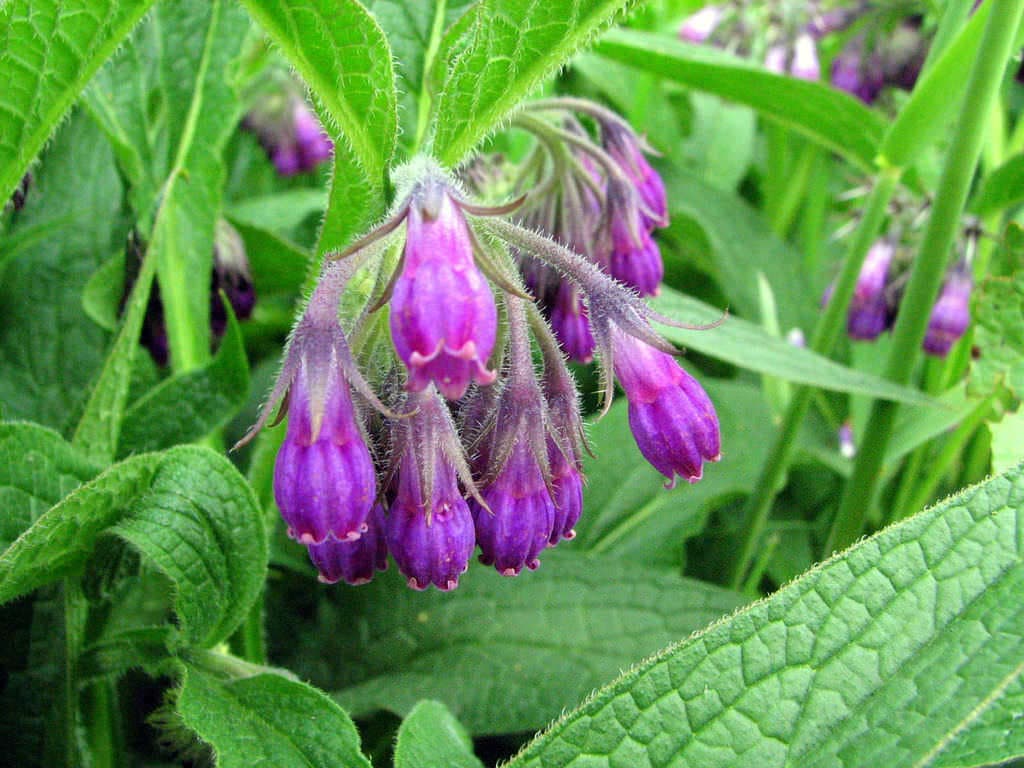
Scientific Name
Symphytum officinale
Common Names
Comfrey, Knitbone
Plant Family
Boraginaceae
Location
Native to Europe and parts of Asia. Found in moist meadows, stream banks, and gardens. Grows quickly and spreads widely. Now cultivated around the world, especially in temperate regions.
Description
Large-leaved perennial with hairy stems and broad, lance-shaped leaves. Bell-shaped purple or cream flowers bloom in clusters. The root is thick, black, and mucilaginous. Feels cooling and healing to the touch.
Uses
Commonly called Comfrey, is chiefly used externally for its strong anti-inflammatory, analgesic, vulnerary, and wound-healing effects. It is well renowned for supporting the repair of soft tissues, such as sprains, strains, bruises, and pulled muscles, owing to its ability to reduce swelling, relieve pain, promote new tissue growth, and accelerate functional recovery. The presence of allantoin supports cell proliferation and connective tissue regeneration, making it useful in healing wounds, broken bones (in external applications, with care), and skin abrasions. Comfrey also exhibits demulcent, mucilaginous properties, which soothe irritated or inflamed mucous membranes, and mild astringent actions from its tannins, helping in superficial skin conditions. There are traditional accounts of its internal uses — for example for diarrhea, ulcers, or gastritis — where its anti-inflammatory, demulcent, and astringent qualities are thought to relieve irritation of the gastrointestinal tract. However, modern medical and regulatory opinion emphasizes that internal use carries risk (due to the pyrrolizidine alkaloids) and is generally not recommended.
Energetics
Cooling, moistening, building. Strongly regenerative and soothing. Brings relief to injured or inflamed tissues.
Parts Used
Leaf and root (primarily external)
Constituents
Allantoin, mucilage, tannins, rosmarinic acid, pyrrolizidine alkaloids (in root and to a lesser extent in leaves)
Dosage
- Infused oil or salve (external): Apply as needed to wounds or joints
- Poultice: Crushed fresh leaves or root applied to affected area
- Internal: Generally avoided due to PA content unless with experienced guidance
Notes on Use
Comfrey is one of the most powerful tissue-healing herbs. It's excellent for sprains, pulled muscles, and post-surgical recovery. Use the leaf in poultices and oils and always ensure the root is used externally only. It's not a “circulating” herb — it builds and repairs — so I usually combine it with something like calendula or yarrow.
Harvesting
• Leaves: Harvest young and vibrant, throughout the season
• Roots: Harvest in fall; chop and dry carefully — very sticky
Contraindications
Not for internal use during pregnancy or in liver-compromised individuals. Avoid prolonged internal use due to PAs. External use is considered safe on unbroken skin.
Recipes
- Healing Salve: Comfrey leaf, calendula, plantain
- Joint Support Oil: Comfrey root, arnica, St. John’s Wort infused in oil
- Poultice for Sprain: Fresh comfrey, yarrow, ginger